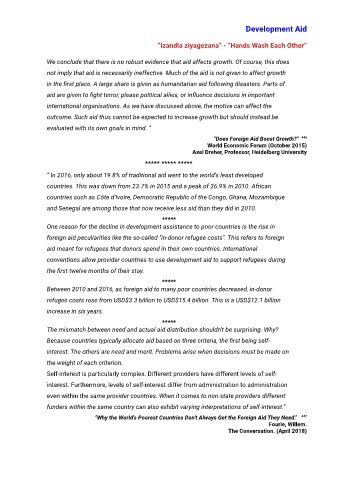Page 397 - Volume 2_CHANGES_merged_with links
P. 397
Development Aid
“Izandla ziyagezana” - “Hands Wash Each Other”
We conclude that there is no robust evidence that aid affects growth. Of course, this does
not imply that aid is necessarily ineffective. Much of the aid is not given to affect growth
in the first place. A large share is given as humanitarian aid following disasters. Parts of
aid are given to fight terror, please political allies, or influence decisions in important
international organisations. As we have discussed above, the motive can affect the
outcome. Such aid thus cannot be expected to increase growth but should instead be
evaluated with its own goals in mind. “
"Does Foreign Aid Boost Growth?" 446
World Economic Forum (October 2015)
Axel Dreher, Professor, Heidelberg University
***** ***** *****
“ In 2016, only about 19.8% of traditional aid went to the world's least developed
countries. This was down from 23.7% in 2015 and a peak of 26.9% in 2010. African
countries such as Côte d'Ivoire, Democratic Republic of the Congo, Ghana, Mozambique
and Senegal are among those that now receive less aid than they did in 2010.
*****
One reason for the decline in development assistance to poor countries is the rise in
foreign aid peculiarities like the so-called "in-donor refugee costs". This refers to foreign
aid meant for refugees that donors spend in their own countries. International
conventions allow provider countries to use development aid to support refugees during
the first twelve months of their stay.
*****
Between 2010 and 2016, as foreign aid to many poor countries decreased, in-donor
refugee costs rose from USD$3.3 billion to USD$15.4 billion. This is a USD$12.1 billion
increase in six years.
*****
The mismatch between need and actual aid distribution shouldn't be surprising. Why?
Because countries typically allocate aid based on three criteria, the first being self-
interest. The others are need and merit. Problems arise when decisions must be made on
the weight of each criterion.
Self-interest is particularly complex. Different providers have different levels of self-
interest. Furthermore, levels of self-interest differ from administration to administration
even within the same provider countries. When it comes to non-state providers different
funders within the same country can also exhibit varying interpretations of self-interest.”
"Why the World's Poorest Countries Don't Always Get the Foreign Aid They Need." 447
Fourie, Willem.
The Conversation. (April 2018)

